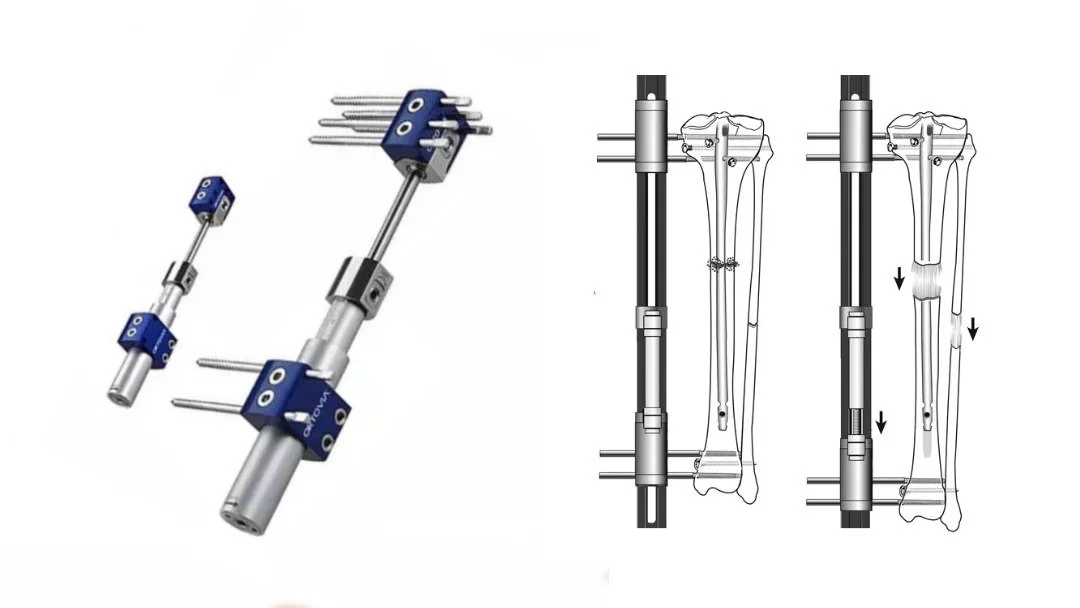Especially in recent years, people who are uncomfortable with their short stature, have leg deformities or were born with limb lenght discrepancy have increase their interest in limb lengthening surgery. With this increase, the number of people wondering about this surgery is increasing day by day. This article provides essential insights into the procedure, covering various leg lengthening techniques, recovery durations, and tips for selecting a skilled and experienced doctors.
The technique of bone lengthening was first introduced in the 1950s. By the early 1980s, in the field of limb lengthening, new devices and methods were explored. For patients who want to lengthen their limbs with developing technology, orthopedic surgeons appropriately combine the body’s ability to grow new bone with the use of special devices and careful observation.
Two prevalent leg lengthening methods exist, each necessitating a bone incision and a stabilizing device. This device can either be inserted within the bone (internal limb lengthening) or put on externally to the leg (external limb lengthening) to extend the legs and straighten deformities.
External Leg Lengthening Surgery Methods
There are 3 different methods for external limb lengthening.
- Lon method,
- Ilizarov method,
- Latn method.
Lengthening Over Nail (LON) Method

Lon is a relatively new method for the lengthening surgery. If a combination of external fixation and intramedullary nailing is performed, this will both reduce the complication rate and shorten the fixation time. It is so important to prevent pin track infection and deep intramedullary sepsis. In this method, there is a need for small nail whic is then attached to external fixator. After the surgery, the patient slowly turns screws to extend the bonds along the nail. The Ilizarov and another monorail fixator can be used for external limb lengthening procedures in LON method.
Ilizarov Method
This method is a revolution for leg lengthening surgeries as it is a technique that allows the bone to stay where it is. The utilization of an outside device, like the Ilizarov apparatus, is called the “external method of leg lengthening”.
The surgery starts with an osteotomy, where a piece of bone is surgically cut, and then the limb is stabilized using a device, often the Ilizarov apparatus.
Typically conducted under general anesthesia, the surgery requires patients to adjust device after the operation. Paired with physical therapy, this method can extend the bone length by 5-8 cm in a single procedure, which usually translates to about 2 to 3 inches of additional bone growth.
Lengthening and Then Nail (LATN) Method
There is a gradual surgical process in the LATN method. Firstly, only an external fixator is installed in the 1st stage surgery, and then, in the 2nd stage surgery, this external fixator is removed and an intramedullary nail is placed instead. Since this is a two-stage surgical process, it is very important that the doctor is competent and knowledgeable in his field. Because increasing the number of surgeries will increase the risks.
A downside is that, because of this extra alignment step, patients might have to wear the external brace for 2 or 3 weeks longer than with LON.
Internal Leg Legthening Surgery Methods
There are 2 methods for internal leg legthening:
- Precice,
- Precice 2,2.
Intramedullary nailing is a way to fix broken bones using a nail or rod inside the bone. For people getting limb-lengthening and who don’t want to carry an external device, there are now advanced technologies, like Precice and Fitbone, that lengthen the bone from the inside.
Precice
Precice is a device put inside the bone to make it longer, involving placing a titanium rod into the bone, and it’s taken out one or two years later with a small surgery. It can make the bone up to 3 inches longer.
Precice 2.2
Precice 2.2 is an updated version of the Precice nails. Its big benefit over the older Precice is that patients can walk while their bone is getting longer. With the older Precice, patients had to use a wheelchair and couldn’t walk because it might break the device, meaning it would need to be replaced.
Recovery Process after Limb Legthening Surgery
Firstly, it should be noted that the recovery process after surgery can vary from patient to patient and depending on the method used. However, if we broadly address this topic;
The first 3 months after surgery are quite important for all patients. This period encompasses a time when height increase occurs and physical therapies are intense. Through the necessary physical therapies, patients’ heights are lengthened by 1mm per day. Therefore, physical therapies and doctor check-ups are quite crucial.
After 3 months, patients can focus on physical therapies to expedite their recovery processes. At this stage, there may be some variations in your physical therapies depending on the surgical method you underwent. We can say that regular check-ups, physical therapy, and x-rays are very important.
One point that patients need to pay utmost attention to during the process after lengthening is to exercise without their doctor’s approval. Doing intense exercise before your recovery process is complete can put excessive stress on your legs and, consequently, complications may occur; therefore, it is extremely important to proceed with this process in coordination with your doctor.
Another point we want to mention is the vitamin D intake during the recovery process after surgery. Since vitamin D supports bone development, it will be quite beneficial for you during this process.
Cost of Limb Discrepancy Surgery:
Limb (either Femur Or Tibia) Lengthening surgery for limb lengthening, with:
- LON method: 19,850 $ (Including removal surgery)
- Precice 2: 47,850 $
- Precice Stryde: Not available
If you have another question, you can contact our patient representatives and you can also follow our Youtube page to follow our patients’ interviews.
SERVICES INCLUDED IN THE SURGERY FEE
- Meeting and greeting our patients at the airports, including all transportation to the airport upon departure,
- Accommodation at Days Hotel by Wyndham Esenyurt, Istanbul (2 days),
- Istanbul tour accompanied by tour guide ,
- All necessary medical examinations before the surgical operation,
- 5 days of Hospitalization,
- An English-speaking caretaker assisting for 6 days,
- 2 Physiotherapy Sessions & Physiotherapist’s assistance,
- Dressing Service,
- A Walker & Crutches & A Wheelchair,
- Discharging with a private ambulance,
- FREE consultation with doctors and consultant ,
- All hospital charges,
- Surgeon fees, Anesthesiologist fees, and Surgery assistant fees.

